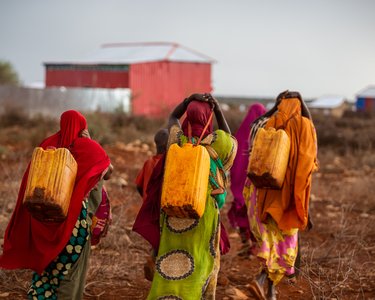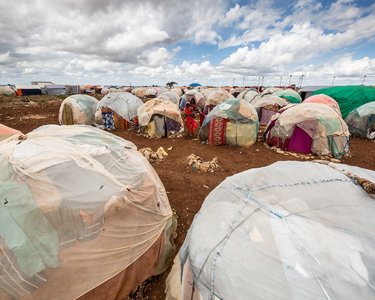
In our November 2023 paper, ‘Somali capacities to respond to crisis are changing; how are humanitarian actors responding?’ we took a different approach in evaluating the 2022-23 drought response in Somalia by asking: If Somalia and its people have evolved - some might argue transformed - since the 2011 famine, has the aid system adapted to the new Somali realities?
Our conclusion was a mitigated but forceful, no.
The future of Somali society
While the response to massive and rapid displacement, for example, did save lives and help prevent famine, it also unintentionally contributed to the persistence of issues such as corruption, marginalisation, and urban precarity. These interconnected problems not only affect the future of Somali society but also undermine the aid response itself. We recommended that the humanitarian aid system use the 'quiet' period between the end of the 22/23 drought crisis and the next major crisis to evolve or even transform, aligning with new context of Somalia to reduce negative outcomes and better achieve objectives like saving lives and preventing famine.
Regrettably we feel that nine months after the report was shared, there are still limited signs of the necessary scale of changes to keep pace with the swift transformations in the Somali context and to address the lessons from the 22/23 failures.
Critical lessons learned
Although change is happening, it lacks a cohesive, system-wide transformative vision.
Following the 2011 famine, widely regarded as a humanitarian failure, many lessons were learned, leading to significant transformations in the aid system. For instance, the prominence of cash transfers in today's aid framework and the extensive use of resilience programming trace their roots to that period, encapsulated by the enduring phrase ‘Never Again.’ However, paradoxically, the narrative of success in preventing famine during 2022/23 seems to have overshadowed critical lessons about response failures - issues that, while less dramatic than famine, heighten risk and vulnerability to the climate crisis and undermine Somalia's future development. Although change is happening, it lacks a cohesive, system-wide transformative vision and is often driven by donors alone.
Addressing corruption and diversion remains a significant focus, likely because of the institutional risks it poses to donors and aid actors. Historically, efforts to mitigate corruption have focused on specific activities like setting up Third Party Monitors, improving feedback mechanisms, adjusting targeting, blacklisting, and technical processes such as biometric identification.
Sustainable system-wide change
However, our review and subsequent work by the Centre for Humanitarian Change and others, emphasises that corruption is a system-wide symptom of how the aid system is structured and operates not merely a ‘disease’ to be eradicated. Sustainable, system-wide change requires altering both the processes and mental models of aid actors, for instance by shifting from a risk transfer approach to one of risk-sharing with Somalis, including both formal and informal institutions.
Efforts to achieve greater equity in the response, particularly regarding marginalization and exclusion, receive less attention, likely due to the complexity of these issues, which are difficult to measure or attribute to specific causes. Since before the 2022/23 emergency, and increasingly after, many humanitarian and development organizations have focused on understanding the socio-political context in their areas of operation. These assessments aim to explore ways to mitigate inequities in the response and address the aid system's role in perpetuating marginalization. The challenge will be adapting project designs to account for the inequitable distribution of power that leads to marginalization, ensuring projects remain adaptable as the context evolves. We feel that developing effective approaches to participation and inclusion for the less powerful must become a key focus.
Displacement as a resilience strategy
The most evident failure of the 2022/23 response, both to Somalis and international observers, was the handling of large-scale drought-related displacement, which drove around a million from rural areas to urban centers where humanitarian efforts are concentrated. Since 2012, the aid response has recognized that displacement is a resilience strategy for rural Somalis, used in extreme situations and as a means to diversify livelihoods. Major crises in 2017/18 and 2022/23 led to significant displacements to urban areas, with many not returning, resulting in large peri-urban populations living in 'urban precarity.' This has exacerbated governance issues, social tensions, marginalization, and corruption within both the aid response and Somali society. Another large-scale displacement is very likely within the next three years, if not sooner, yet it is unclear whether humanitarians, development actors, and the government are working together to avoid repeating the mistakes of past displacement responses.
Comprehensive reform urgently needed
Key issues that are urgent for the government and aid agencies to address include a comprehensive reform of the IDP camp approach, which has turned displacement into a business opportunity, worsening precarity, corruption, and marginalisation. While there may be no perfect alternative for ensuring a rapid and efficient response to large-scale displacement into urban areas, the aid system must confront this challenge head-on, recognizing the necessary trade-offs. Much of the longer-term aftermath of large-scale displacement into urban areas is considered the responsibility of Durable Solutions actors. However, the way humanitarians receive, organise, and support new and prolonged displaced populations seems disconnected from the objectives of Durable Solutions and vice versa. Nine months on we continue to urge humanitarians and Durable Solutions actors to use this relatively quiet period before the next large-scale displacement crisis to ensure their interventions complement and support each other, avoiding the failures of the last decade.
The aid response has only partially adapted to the highly networked nature of Somali society and the ubiquity of social networks. It is crucial to design the next crisis response with the understanding that a displaced person or family is a node in a wide social network, connecting individuals, families, and communities across geographic and security boundaries. Cash transfer programmes and efforts to increase inclusion and participation are clear priorities for leveraging the networked nature of Somali society.
Collective vision to transform humanitarian response
The scale and depth of change required before the next major crisis can only be achieved through the adoption of a system-wide collective vision.
Having observed and engaged in Somalia over many years, my experience is that the Somali aid system is the most responsive and adaptive in the region, despite challenges such as high staff turnover, limited access, and financial constraints. However, the scale and depth of change required before the next major crisis can only be achieved through the adoption of a system-wide collective vision—one that transforms the humanitarian aid response to align with the ongoing, interconnected transformations within Somali society.
Watch report launch webinar: Somali capacities to respond to crisis
You might also be interested in…

